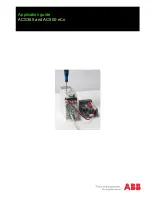
HT82M75REW/HT82K75REW
Rev. 1.00
19
June 11, 2010
In addition, on entering an interrupt sequence or execut-
ing a subroutine call, the status register will not be
pushed onto the stack automatically. If the contents of
the status registers are important and if the interrupt rou-
tine can change the status register, precautions must be
taken to correctly save it.
Interrupt Control Registers
-
INTC
The microcontroller provides an internal timer/event
counter overflow interrupt. By setting various bits within
this register using standard bit manipulation instruc-
tions, the enable/disable function of each interrupt can
be independently controlled. A master interrupt bit within
this register, the EMI bit, acts like a global enable/dis-
able and is used to set all of the interrupt enable bits on
or off. This bit is cleared when an interrupt routine is en-
tered to disable further interrupt and is set by executing
the
²
RETI
²
instruction.
Timer/Event Counter Registers
-
TMRH, TMRL, TMRC
All devices possess a single internal 16-bit count-up
t i m e r. A n a s s o c i a t e d r e g i s t e r p a i r k n o w n a s
TMRL/TMRH is the location where the timer 16-bit value
is located. This register can also be preloaded with fixed
data to allow different time intervals to be setup. An as-
sociated control register, known as TMRC, contains the
setup information for this timer, which determines in
what mode the timer is to be used as well as containing
the timer on/off control function.
Watchdog Timer Register
-
WDTS
The Watchdog function in the microcontroller provides
an automatic reset function giving the microcontroller a
means of protection against spurious jumps to incorrect
Program Memory addresses. To implement this, a timer
is provided within the microcontroller which will issue a
reset command when its value overflows.To provide
variable Watchdog Timer reset times, the Watchdog
Timer clock source can be divided by various division ra-
tios, the value of which is set using the WDTS register.
By writing directly to this register, the appropriate divi-
sion ratio for the Watchdog Timer clock source can be
setup. Note that only the lower 3 bits are used to set divi-
sion ratios between 1 and 128.
Input/Output Ports and Control Registers
Within the area of Special Function Registers, the I/O
registers and their associated control registers play a
prominent role. All I/O ports have correspondingly des-
ignated registers known as PA, PB, etc. These labeled
I/O registers are mapped to specific addresses within
the Data Memory as shown in the Data Memory table,
which are used to transfer the appropriate output or in-
put data on that port. With each I/O port there is an asso-
ciated control register known as PAC, PBC, etc., also
mapped to specific addresses with the Data Memory.
Input/Output Ports
Holtek microcontrollers offer considerable flexibility on
their I/O ports. With the input or output designation of ev-
ery pin fully under user program control, pull-high op-
tions for all ports and Wake-up option for all I/O pins, the
user is provided with an I/O structure to meet the needs
of a wide range of application possibilities.
The microcontroller provides 24 or 40 bit bidirectional in-
put/output lines labeled with port names known as PA,
PB, etc. These I/O ports are mapped to the Data Mem-
ory with addresses as shown in the Special Purpose
Data Memory table. All of these I/O lines can be used for
input and output operations and one line as an input
only. For input operation, these ports are non-latching,
which means the inputs must be ready at the T2 rising
edge of instruction
²
MOV A,[m]
²
, where m denotes the
port address. For output operation, all the data is latched
and remains unchanged until the output latch is rewritten.
Pull-high Resistors
Many product applications require pull-high resistors for
their switch inputs usually requiring the use of an exter-
nal resistor. To eliminate the need for these external re-
sistors, I/O pins, when configured as an input have the
capability of being connected to an internal pull-high re-
sistor. The pull-high resistors are selectable via configu-
ration options and are implemented using weak PMOS
transistors. The individual pull-high resistor is selected
to be connected to each pin on Port A by a configuration
option. A configuration option can determine if the
pull-high resistors are connected to the lower significant
four pins or higher significant four pins on each I/O port
except Port A.
Port Pin Wake-up
If the HALT instruction is executed, the device will enter
the Power Down Mode, where the system clock will stop
resulting in power being conserved, a feature that is im-
portant for battery and other low-power applications.
Various methods exist to wake-up the microcontroller,
one of which is to change the logic condition on one of
the port pins from high to low. After a HALT instruction
forces the microcontroller into entering the Power Down
Mode, the processor will remain in a low-power state un-
til the logic condition of the selected wake-up pin on the
port pin changes from high to low. This function is espe-
cially suitable for applications that can be woken up via
external switches. All of the I/O pins can be configured
to have the capability to wake-up the device by high to
low and low to high edges using different configuring
ways. It means once the I/O pin is configured to have the
electronic components distributor
















































